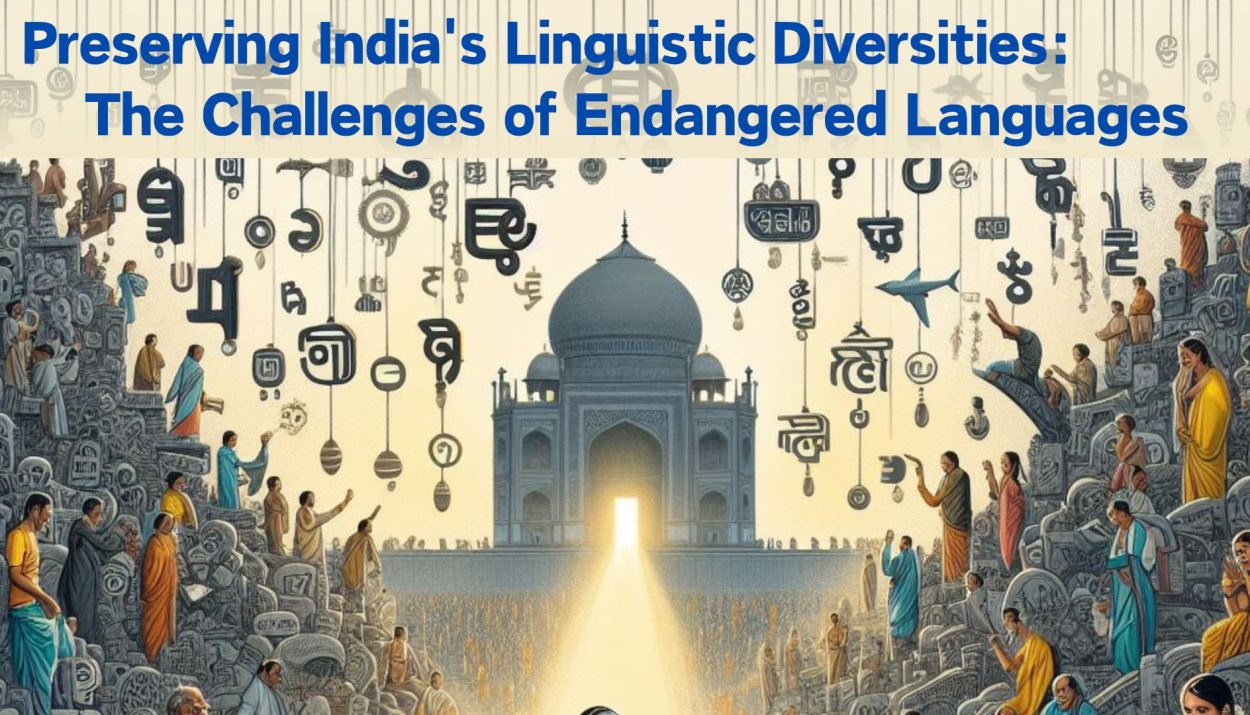India often referred to as a melting pot of cultures and traditions, boasts incredible linguistic diversity with a rich tapestry of languages spoken across the length and breadth of the country. However, this linguistic heritage is facing an alarming threat as several languages are teetering on the brink of extinction. The phenomenon of endangered languages in India is a pressing issue that demands attention and concerted efforts for preservation. “Exploring the intricacies of Preserving India’s Linguistic Diversities: The Challenges of Endangered Languages” highlights the urgent need for concerted efforts to safeguard and revitalize linguistic richness.
The disappearance of languages represents more than a loss to a nation’s cultural heritage; it signifies a diminishment in the broader scope of human history. The United Nations General Assembly has designated 2022 to 2032 as the International Decade of Indigenous Languages to safeguard indigenous languages worldwide.
Read- International Mother Language Day
The Linguistic Landscape
India is home to a staggering number of languages, with the Constitution recognizing 22 officially recognized languages (8th Schedule of the Indian Constitution). This linguistic diversity is a testament to the country’s pluralistic ethos, but it also presents a unique challenge in terms of language preservation. According to the Constitution of India, there is no designated national language. Following independence, the framers of the Constitution faced the challenge of choosing a language that could serve as a unifying force for the diverse nation, given the existence of over 1,600 languages spoken in various regions.
As indicated in the “Atlas of the World’s Languages in Danger,” a publication by the United Nations Educational, Cultural and Scientific Organization (UNESCO) in 2010, India is home to 197 languages facing the threat of extinction. The primary goal of the Atlas is to raise awareness about the diminishing linguistic diversity worldwide. The report classifies endangered languages into five categories: ‘vulnerable,’ ‘definitely endangered,’ ‘severely endangered,’ ‘critically endangered,’ and ‘extinct.’ Here are some examples:
Great Andamanese (spoken by tribes in the north, south, and middle of the Great Andaman): Critically endangered.
Balti (spoken in the Nubra Valley of the Leh district and the Kargil district of Ladakh): Vulnerable.
Asur (spoken in Jharkhand): Severely endangered language.

While endangered languages are spread across India, certain regions are particularly vulnerable. The northeastern states, with their rich tapestry of tribal languages, face significant challenges. Similarly, languages spoken by smaller communities in remote areas of central and southern India are also at risk. Efforts to document and revitalize these languages are crucial to preserving the unique cultural and linguistic heritage they represent.
Factors Contributing to Endangerment
Linguistic Diversity: India is home to an extraordinarily diverse linguistic landscape, with over 1,600 languages spoken. The coexistence of numerous languages in a relatively small geographical area can lead to linguistic competition and the marginalization of smaller languages.
Urbanization and Migration: The rapid urbanization and migration of people from rural to urban areas often result in the dominance of major languages used in cities. This can lead to a decline in the use and transmission of indigenous languages spoken in rural communities.
Globalization: The widespread influence of global media and the dominance of major world languages in international communication contribute to the marginalization of local languages. English, in particular, is often seen as a gateway to economic opportunities and global connectivity, leading to a decline in the use of regional languages.
Educational Policies: The language of instruction in educational institutions plays a crucial role in shaping language vitality. Policies that promote the use of a single dominant language in schools may undermine the survival of regional languages, particularly if there is limited support for bilingual education.
Economic Factors: Economic opportunities associated with proficiency in certain languages can drive individuals and communities to shift towards more economically advantageous languages, further marginalizing indigenous languages that may not offer the same economic benefits.
Cultural Shifts: Changing societal values and cultural practices, influenced by urbanization and globalization, can contribute to a decreased emphasis on the importance of local languages. Younger generations may be more inclined to adopt languages associated with modernity and progress.
Lack of Documentation and Preservation Efforts: Many endangered languages lack proper documentation and preservation efforts. Without written records or digital resources, these languages face a higher risk of disappearing as they rely solely on oral transmission.
Government Policies: Government policies related to language use and promotion can have a significant impact. Policies that do not adequately recognize and support linguistic diversity may inadvertently contribute to the endangerment of certain languages.
Preservation of Endangered Languages
Preserving endangered languages in India presents a complex challenge. Economic factors, societal attitudes, and the influence of global languages all contribute to the decline of smaller languages. Solutions must involve a multi-faceted approach, including educational reforms, community empowerment, and technological interventions. Collaborations between linguists, communities, and policymakers are essential for crafting effective strategies.
Government Initiatives: Recognizing the urgency of the situation, the Indian government has taken steps to address the issue of endangered languages. The Central Institute of Indian Languages (CIIL) has been at the forefront of efforts to document and revitalize endangered languages. Established in 1969 and currently under the administrative purview of the Ministry of Education (formerly the Ministry of Human Resources), this organization provides guidance and support to both Central and State Governments on language-related issues. Additionally, the National Translation Mission aims to bridge the language gap by promoting the translation of knowledge and information into various Indian languages.
To address the issue, the Government of India has launched the “Protection and Preservation of Endangered Languages of India” initiative. Within the framework of this scheme, the Central Institute of Indian Languages (CIIL) in Mysore is actively engaged in safeguarding, preserving, and documenting all mother tongues and languages spoken in India by fewer than 10,000 individuals. This effort is particularly focused on languages facing a high degree of endangerment and a decline in their practical applications (PIB-2014).
Community-Led Conservation: While government initiatives are essential, grassroots efforts are equally crucial for the preservation of endangered languages. Many linguistic communities have taken the lead in documenting and revitalizing their languages through community-driven projects. These efforts involve oral history preservation, language education programs, and the creation of written materials in endangered languages.
Conclusion
India’s linguistic diversity is a source of cultural richness, reflecting the country’s historical and geographical complexities. The endangerment of languages is not merely a loss of words; it signifies the erasure of unique worldviews, traditions, and knowledge systems. As India celebrates its linguistic mosaic, it is crucial to recognize the urgency of preserving endangered languages. The diverse linguistic heritage of India stands at a crossroads, and concerted efforts are needed to ensure that the voices that echo through these endangered languages continue to resonate in the cultural symphony of the nation. It is a call to action — a plea to recognize, appreciate, and protect the linguistic legacy that is an integral part of India’s identity.
References
India has lost 220 languages in 50 years
Meet the people who are giving lost languages a voice
Extinct, endangered, vulnerable: Tale of India’s linguistic heritage
The Endangered And Extinct Languages Of India
196 Indian languages ’endangered’: UNESCO







